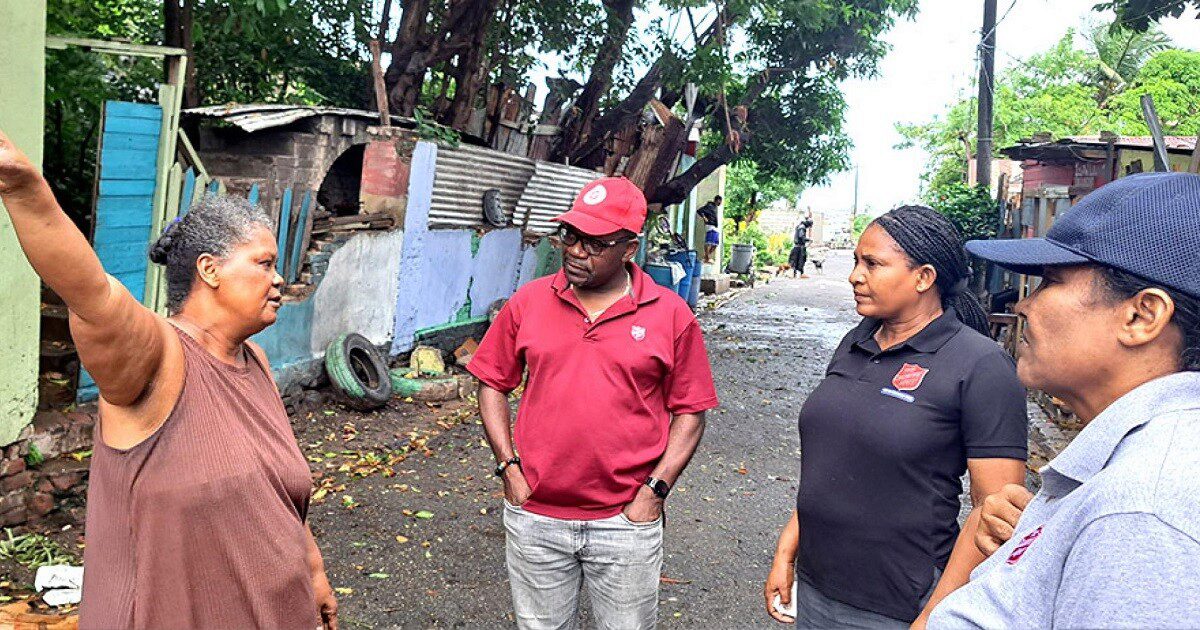Salvation Army teams in the Caribbean and along the east coast of the USA are providing assistance to people affected by Hurricane Irene. At this time 40 people are known to have died as a result of the hurricane. However, although there was not as much damage as had initially been feared, many thousands of people are having to deal with severe flooding and damage caused by the rain and high winds.
Before the hurricane struck the USA The Salvation Army had already moved personnel and vehicles into strategic staging locations in North Carolina and Pennsylvania. Disaster response teams were on the ground from Florida to Maine, serving first responders, assisting during the evacuation of low-lying areas, distributing food at shelters and providing a broad range of support before Hurricane Irene made landfall.
In total, The Salvation Army has 370 canteens and five mobile feeding kitchens operating throughout the affected region. Collectively, these stations can provide several hundred thousand meals per day when serving at full capacity.
In Puerto Rico, one of the first islands to be reached by the hurricane, The Salvation Army supported homeless, sick and disabled people. Distribution of food and water supplies is well under way on the Bahamas, where The Salvation Army has been asked to provide disaster relief service on Long Island and Cat Island. There is a plan to ship Meals Ready to Eat (MREs) and bottled water to Turks and Caicos.
In addition, representatives of The Salvation Army's Emergency Disaster Service Team have been asked to partner with the Bahamas National Emergency Management Agency (NEMA) to survey and assess the damage on the islands of Acklins and Mayaguana.
The Salvation Army is also providing support and helping with the clean-up operation in the Dominican Republic.
In the USA, Salvation Army damage assessment teams throughout North Carolina, Virginia, Maryland and Delaware are receiving a broad range of assistance requests. Thousands of people are still affected by widespread power loss and flooding caused by the hurricane. Shelters across the affected area are housing thousands of evacuees – especially those from low-lying areas prone to storm surge. Most of The Salvation Army's current response is focused on mass feeding of evacuees and providing assistance to fire, rescue, police and other emergency response personnel.
'The initial damage reports are leaving us cautiously optimistic that there has not been widespread structural damage or injuries,' says Major George Hood, National Community Relations Secretary in the USA. 'But flooding remains a problem, particularly in New England, and there is a significant response ongoing. It is critical that we provide the base of support for damage assessment teams, rescue personnel and survivors.'
Dozens of emergency canteens are on the move along the east coast, heading to shelter locations and in support of roving emergency responders.
The Salvation Army is providing a broad range of services, in coordination with local, state and federal governments. These services include:
• Serving 15,000 meals to first responders and evacuees in New Jersey.
• Providing 14,000 meals, snacks and drinks in Greenville, Washington DC, and Elizabeth City and Morehead City in the Carolinas.
• In Norfolk and Spotsylvania Counties, Virginia, The Salvation Army has served more than 6,400 meals, snacks and drinks and provided lodging to 265 people.
• More than 5,000 meals, snacks and drinks have been provided at multiple shelter locations throughout Maryland and West Virginia.
• In Connecticut, The Salvation Army has served hundreds of meals to evacuees at shelters as well as to first responders.
• The Salvation Army is providing meals at numerous shelter facilities throughout Massachusetts and other parts of New England.
The situation is changing by the hour.
Read the latest news from the Caribbean here and find up-to-date information about the response in the USA on The Salvation Army's USA National website (this site also includes links to the USA National blog, Facebook page and Twitter feed).
Before the hurricane struck the USA The Salvation Army had already moved personnel and vehicles into strategic staging locations in North Carolina and Pennsylvania. Disaster response teams were on the ground from Florida to Maine, serving first responders, assisting during the evacuation of low-lying areas, distributing food at shelters and providing a broad range of support before Hurricane Irene made landfall.
In total, The Salvation Army has 370 canteens and five mobile feeding kitchens operating throughout the affected region. Collectively, these stations can provide several hundred thousand meals per day when serving at full capacity.
In Puerto Rico, one of the first islands to be reached by the hurricane, The Salvation Army supported homeless, sick and disabled people. Distribution of food and water supplies is well under way on the Bahamas, where The Salvation Army has been asked to provide disaster relief service on Long Island and Cat Island. There is a plan to ship Meals Ready to Eat (MREs) and bottled water to Turks and Caicos.
In addition, representatives of The Salvation Army's Emergency Disaster Service Team have been asked to partner with the Bahamas National Emergency Management Agency (NEMA) to survey and assess the damage on the islands of Acklins and Mayaguana.
The Salvation Army is also providing support and helping with the clean-up operation in the Dominican Republic.
In the USA, Salvation Army damage assessment teams throughout North Carolina, Virginia, Maryland and Delaware are receiving a broad range of assistance requests. Thousands of people are still affected by widespread power loss and flooding caused by the hurricane. Shelters across the affected area are housing thousands of evacuees – especially those from low-lying areas prone to storm surge. Most of The Salvation Army's current response is focused on mass feeding of evacuees and providing assistance to fire, rescue, police and other emergency response personnel.
'The initial damage reports are leaving us cautiously optimistic that there has not been widespread structural damage or injuries,' says Major George Hood, National Community Relations Secretary in the USA. 'But flooding remains a problem, particularly in New England, and there is a significant response ongoing. It is critical that we provide the base of support for damage assessment teams, rescue personnel and survivors.'
Dozens of emergency canteens are on the move along the east coast, heading to shelter locations and in support of roving emergency responders.
The Salvation Army is providing a broad range of services, in coordination with local, state and federal governments. These services include:
• Serving 15,000 meals to first responders and evacuees in New Jersey.
• Providing 14,000 meals, snacks and drinks in Greenville, Washington DC, and Elizabeth City and Morehead City in the Carolinas.
• In Norfolk and Spotsylvania Counties, Virginia, The Salvation Army has served more than 6,400 meals, snacks and drinks and provided lodging to 265 people.
• More than 5,000 meals, snacks and drinks have been provided at multiple shelter locations throughout Maryland and West Virginia.
• In Connecticut, The Salvation Army has served hundreds of meals to evacuees at shelters as well as to first responders.
• The Salvation Army is providing meals at numerous shelter facilities throughout Massachusetts and other parts of New England.
The situation is changing by the hour.
Read the latest news from the Caribbean here and find up-to-date information about the response in the USA on The Salvation Army's USA National website (this site also includes links to the USA National blog, Facebook page and Twitter feed).









Leave a Comment